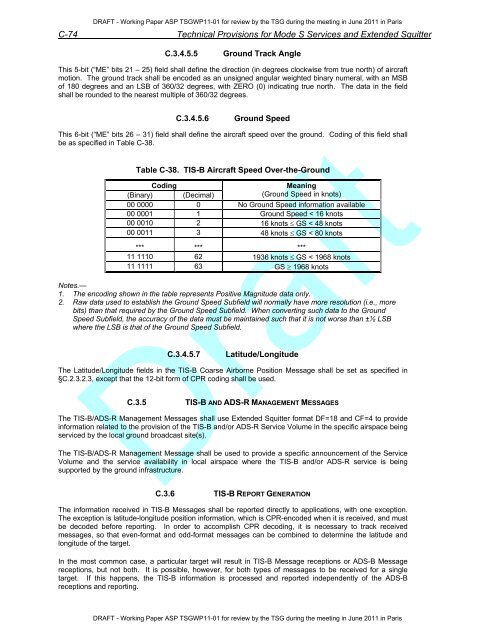Technical Provisions for Mode S Services and Extended Squitter
Technical Provisions for Mode S Services and Extended Squitter
Technical Provisions for Mode S Services and Extended Squitter
You also want an ePaper? Increase the reach of your titles
YUMPU automatically turns print PDFs into web optimized ePapers that Google loves.
DRAFT - Working Paper ASP TSGWP11-01 <strong>for</strong> review by the TSG during the meeting in June 2011 in Paris<br />
C-74 <strong>Technical</strong> <strong>Provisions</strong> <strong>for</strong> <strong>Mode</strong> S <strong>Services</strong> <strong>and</strong> <strong>Extended</strong> <strong>Squitter</strong><br />
C.3.4.5.5 Ground Track Angle<br />
This 5-bit (“ME” bits 21 – 25) field shall define the direction (in degrees clockwise from true north) of aircraft<br />
motion. The ground track shall be encoded as an unsigned angular weighted binary numeral, with an MSB<br />
of 180 degrees <strong>and</strong> an LSB of 360/32 degrees, with ZERO (0) indicating true north. The data in the field<br />
shall be rounded to the nearest multiple of 360/32 degrees.<br />
C.3.4.5.6 Ground Speed<br />
This 6-bit (“ME” bits 26 – 31) field shall define the aircraft speed over the ground. Coding of this field shall<br />
be as specified in Table C-38.<br />
Table C-38. TIS-B Aircraft Speed Over-the-Ground<br />
Coding<br />
Meaning<br />
(Binary) (Decimal)<br />
(Ground Speed in knots)<br />
00 0000 0 No Ground Speed in<strong>for</strong>mation available<br />
00 0001 1 Ground Speed < 16 knots<br />
00 0010 2 16 knots ≤ GS < 48 knots<br />
00 0011 3 48 knots ≤ GS < 80 knots<br />
*** *** ***<br />
11 1110 62 1936 knots ≤ GS < 1968 knots<br />
11 1111 63 GS ≥ 1968 knots<br />
Notes.—<br />
1. The encoding shown in the table represents Positive Magnitude data only.<br />
2. Raw data used to establish the Ground Speed Subfield will normally have more resolution (i.e., more<br />
bits) than that required by the Ground Speed Subfield. When converting such data to the Ground<br />
Speed Subfield, the accuracy of the data must be maintained such that it is not worse than ±½ LSB<br />
where the LSB is that of the Ground Speed Subfield.<br />
C.3.4.5.7 Latitude/Longitude<br />
The Latitude/Longitude fields in the TIS-B Coarse Airborne Position Message shall be set as specified in<br />
§C.2.3.2.3, except that the 12-bit <strong>for</strong>m of CPR coding shall be used.<br />
Draft<br />
C.3.5 TIS-B AND ADS-R MANAGEMENT MESSAGES<br />
The TIS-B/ADS-R Management Messages shall use <strong>Extended</strong> <strong>Squitter</strong> <strong>for</strong>mat DF=18 <strong>and</strong> CF=4 to provide<br />
in<strong>for</strong>mation related to the provision of the TIS-B <strong>and</strong>/or ADS-R Service Volume in the specific airspace being<br />
serviced by the local ground broadcast site(s).<br />
The TIS-B/ADS-R Management Message shall be used to provide a specific announcement of the Service<br />
Volume <strong>and</strong> the service availability in local airspace where the TIS-B <strong>and</strong>/or ADS-R service is being<br />
supported by the ground infrastructure.<br />
C.3.6 TIS-B REPORT GENERATION<br />
The in<strong>for</strong>mation received in TIS-B Messages shall be reported directly to applications, with one exception.<br />
The exception is latitude-longitude position in<strong>for</strong>mation, which is CPR-encoded when it is received, <strong>and</strong> must<br />
be decoded be<strong>for</strong>e reporting. In order to accomplish CPR decoding, it is necessary to track received<br />
messages, so that even-<strong>for</strong>mat <strong>and</strong> odd-<strong>for</strong>mat messages can be combined to determine the latitude <strong>and</strong><br />
longitude of the target.<br />
In the most common case, a particular target will result in TIS-B Message receptions or ADS-B Message<br />
receptions, but not both. It is possible, however, <strong>for</strong> both types of messages to be received <strong>for</strong> a single<br />
target. If this happens, the TIS-B in<strong>for</strong>mation is processed <strong>and</strong> reported independently of the ADS-B<br />
receptions <strong>and</strong> reporting.<br />
DRAFT - Working Paper ASP TSGWP11-01 <strong>for</strong> review by the TSG during the meeting in June 2011 in Paris
















